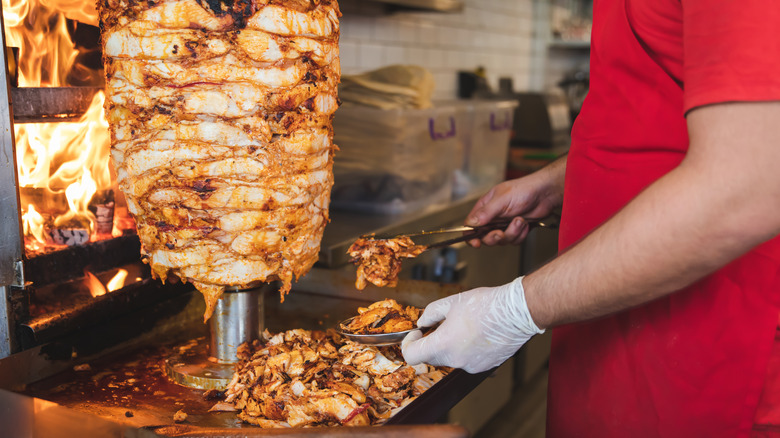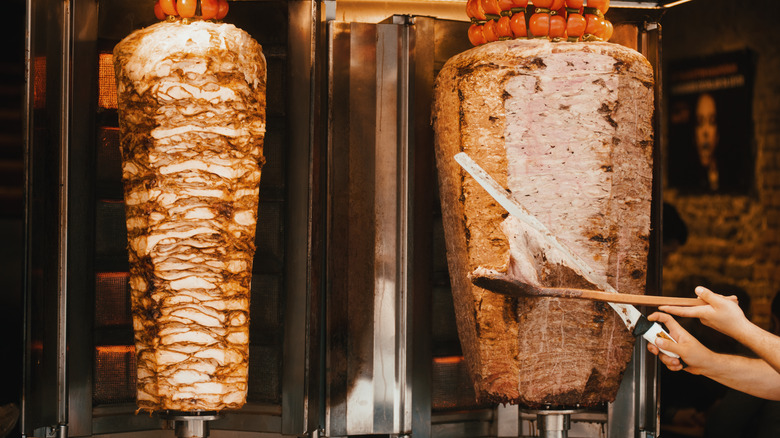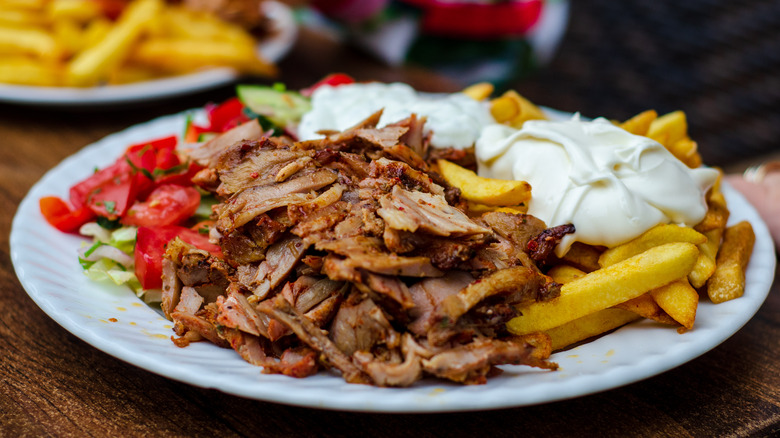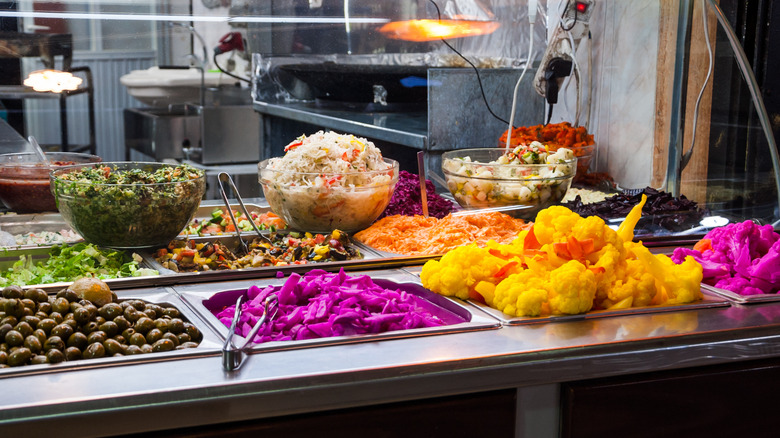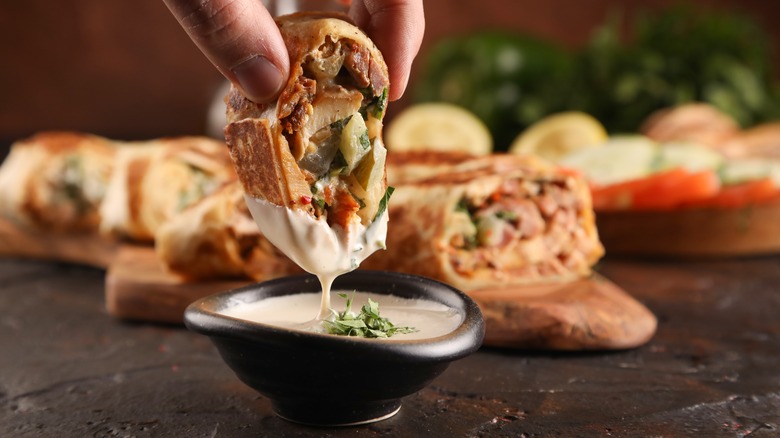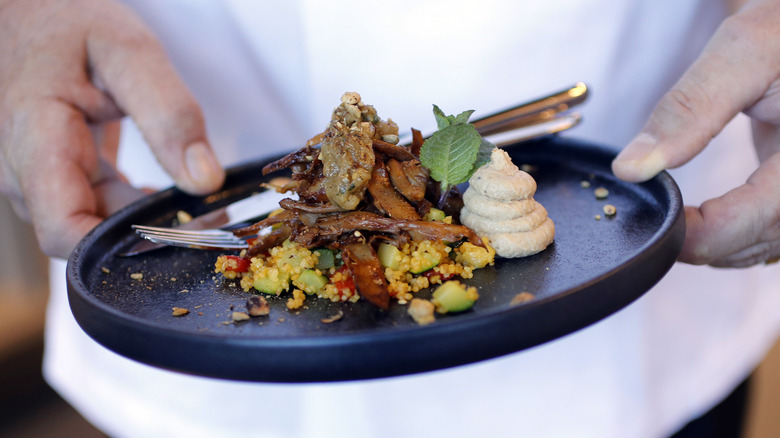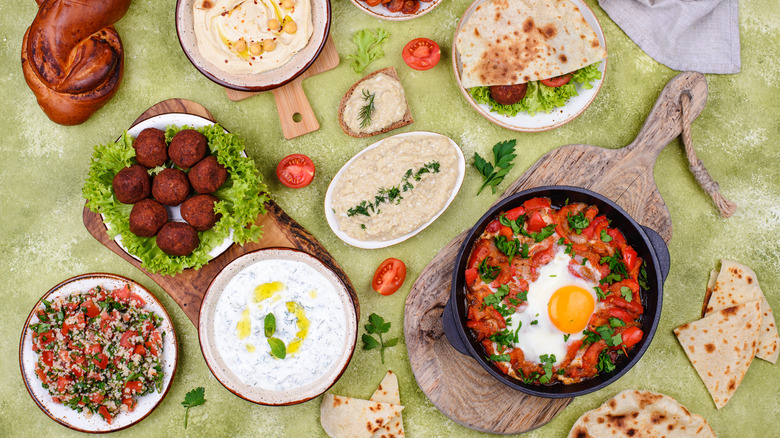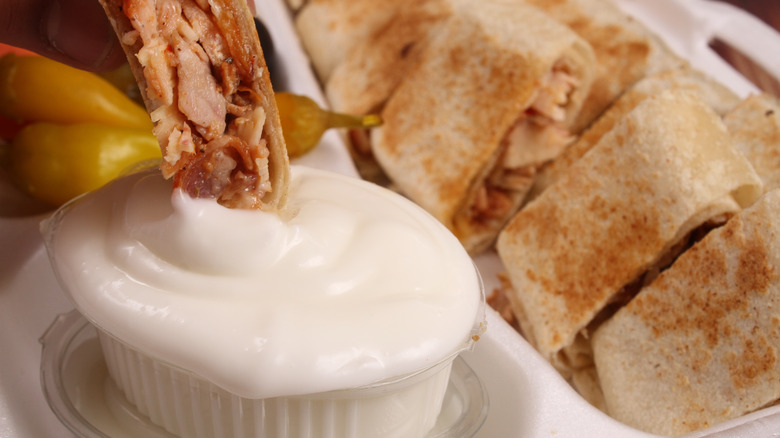The Untold Truth Of Shawarma
Shawarma, a classic Middle Eastern street food delicacy, is the perfect savory bite of tender meat, fluffy pita bread, and warming spice blends. Similar to gyros, shawarma is a typical street food that can be found across the globe and is known for its bold, deep flavor profiles. Whether you're on a noisy street in Tel Aviv or in the comfort of your own home, shawarma is an amazing way to experience the authentic, century-old flavors of the Middle East.
The preparation of shawarma is a crucial part of the significance and historical authenticity of the dish, and while times have changed since the birth of shawarma this technique has remained extremely strong throughout many parts of the globe. To fully understand shawarma, it's important to understand the key parts that have prompted it to become what it is today. Often, as previously mentioned, shawarma is compared to both gyros and burritos due to the similarities of meat wrapped up in a blanket of bread.
The spinning rotisserie machine is key to shawarma's taste and texture
Shawarma is a Middle Eastern dish typically prepared with chicken or lamb, cooked on a vertical rotisserie, and cut into extremely thin pieces. Taste Atlas explains that in the Middle East, shawarma is one of the most popular street foods and has become increasingly well-known throughout the world in recent years. According to Spinning Grillers, the rotisserie machine is essential for the preparation of shawarma and creates a moist, soft cut of meat that pairs perfectly with the toppings that often accompany it inside of the bread.
The meat on the vertical rotisserie is stacked high, and after it's done cooking it gets shaved down in a vertical motion to create the lean pieces that it's known for. According to Taste Atlas, this spinning, vertical cooking technique can last for a number of hours with regular basting in order to achieve the vital texture that shawarma meat carries. As noted on the Blend of Spice blog, tomatoes or onions are often placed at the top of the shawarma rotisserie skewers to secure the machine in place.
The historic roots of shawarma
According to The Cape Gazette, the origins of shawarma date back all the way to the Ottoman Empire around the 18th century, and the word itself translates to "turning" in Arabic (via Taste Atlas). It holds very close ties to modern-day Turkey, and traditionally the marinades for the meat included yogurt, vinegar, and tons of fragrant spices. In the past, shawarma would have been cooked over an open fire, but in the modern-day, gas or electric heat is used to provide the proper cooking of the meat.
The vertical rotisserie style of cooking was also known to have originated around the 18th or 19th century, and was utilized to prioritize the flavor and tenderness of the meat (via Neomonde Mediterranean). As noted in the Food Zodiac, in the 1800's a man named Iskender Efendi in Turkey made the first rolled shawarma, which is more closely related to what we see today. As Always Flavored has noted, the meaning of the word shawarma may have originated from Egyptian shepherds and their cooking techniques of hanging lamb over an open flame. The lamb would be turned in a slow pattern to ensure an even distribution of heat.
Aromatic spices make shawarma what it is today
The spices in shawarma consist of coriander, allspice, turmeric, cinnamon, cumin, ginger, and black pepper (via McCormick). They're incredibly warming and make for a flavorful, delicious dish as if you're taking a bite straight out of the Middle East. The signature shawarma spice blend is the backbone of the dish, giving it that popular and recognizable pop of flavor that separates shawarma from other classic Middle Eastern foods. While the spice blends offer a ton of flavor to the shawarma, it's also important for the deep, rich color of the outside of the meat.
Although some renditions of shawarma differ across the Mediterranean and across the globe, the core spices within shawarma remain the same throughout (via Always Flavored). Some of these spices show up in other cuisines that surround The Middle East, like Indian cuisine and Southeast Asian cuisine. Individual spices like cinnamon and allspice might seem like an odd addition to savory foods, but when paired with their partner seasonings the group of flavors sing together.
Shawarma can feature a variety of meats
As stated in the Spruce Eats, Shawarma is typically made from chicken, lamb, beef, goat, or turkey and includes fat in between each meat layer to offer the tender, juicy aspect that makes shawarma so delicious. If you're preparing chicken shawarma at home, try to use chicken thighs rather than chicken breasts for a cut of chicken with more natural fat. According to the Jamrah Middle Eastern restaurant in Illinois, in the modern-day, some renditions of shawarma even use more out-of-the-box meat varieties like veal. Sometimes when serving shawarma there are even a mix of meats combined together, and when that's the case a popular combination is chicken and lamb.
The countries that shawarma predominately originate from have large Jewish and Islam populations, and because of this, the meat used for shawarma needs to be slaughtered in either a kosher or halal way, depending on who is consuming it. As written by Oukosher.org, for these kosher and halal laws to be upheld it's important to be sure of who is slaughtering the animal, how it was raised, and that the process is done perfectly according to the regulations. If these processes are not done to the T, the people keeping these laws would not be able to consume the shawarma.
Shawarma is popular in Canada
Shawarma is eaten heavily in Egypt, Turkey, Israel, and Lebanon but according to CBC News it has recently become even more well known in The United States and Canada, specifically Ottawa. As Ontario Culinary explains, from the 1970s to the 1990s, Lebanese refugees made their way to Canada and a lot of those refugees landed in Ottawa, bringing themselves and their cultural cuisines with them (via Ontario Culinary). A notable shawarma restaurant in Ottawa that attracts tons of tourists is Shawarma Palace, featuring both chicken and beef shawarma, as well as an array of different authentic options (via The Charlatan). In the last 10 to 15 years, shawarma businesses have boomed due to the relatively easy nature of the set-up of the shop.
Because of this boom, Ottawa has gained a lot of shawarma competition across the city and attracted many Canadians from other cities who are eager to try the food. Alongside Ottawa, Montreal also has a large number of shawarma restaurants and even more on the rise. The Sumac Restaurant located in Montreal features a chicken shawarma pita with all the fixings, topped with tahini, Israeli salad, and pickled turnips.
Narrowing down the Middle East: the best shawarma in Israel
Shawarma is eaten daily in Israel, as both a popular street food and in more elegant restaurants. According to Afar, one of the most well-known places for tourists to visit in Tel Aviv is Falafel Hakosem. One might guess from the name of the restaurant that they serve amazing falafel, but they're also known for their flavorful and classic shawarma. Whether it's in a fluffy pita or served on a plate with pickled vegetables and fresh herbs, this dish speaks volumes.
Some of the most beloved shawarma restaurants are found in the north of Israel, like Shawarma Emil which has been serving the admired dish for over 50 years (via Israel.com). In Jerusalem, the Mifgash Ha'esh café has been serving shawarma for 30 years and has hosted important members of the Israeli Parliament such as Menachem Begin for freshly prepared Israeli food (via Israelkosherdining). Referenced on Israel.com, This café prepares a special rendition of shawarma made with pullet, a young chicken, and topped with lamb fat. If you're interested in shawarma and are visiting Jerusalem, this is the place to go.
Shawarma around The United States
Shawarma and Middle Eastern food, in general, has been booming around the U.S. Oakland, California's Shawarmaji, for example, serves shawarma fries, with crispy fried potatoes topped with shawarma spices, and served alongside pickles, turnips, and toum sauce. The restaurant's housemade sauce helps to set their shawarma apart from others in the area and even across the country. A highly admired restaurant in New York City, 19 Cleveland which serves specifically Tel Avivian cuisine, has both chicken and fish shawarma on the menu.
While this restaurant is a true ode to Tel Aviv, it touches other Middle Eastern flavors and offers both an authentic and creative take on shawarma that consumers might not be used to. Fish is not a classic protein used in shawarma, and this dish gives pescatarians and people striving to eat less meat the ability to enjoy the flavors of shawarma.
Another restaurant in Manhattan's Greenwich Village called Shuka features a spit-roasted chicken shawarma, with braised onions, red cabbage, herbs, and flatbread. For a less expensive option to cook in your personal kitchen, check out Trader Joe's chicken shawarma thighs. They're pre-marinated and portioned out, making for an easy and delicious weeknight dinner staple.
Different forms of shawarma: the path to plant based
Vegan shawarma is dominating the food industry, available in both restaurants and pre-packaged meals among different supermarkets. Some vegan versions of this Middle Eastern delicacy are made of fake meat, like seitan, and some are straight-up vegetables, highlighting mushrooms, eggplant, and even cauliflower (via Tenderly). As seen on the menu at Taim, a tasty Mediterranean restaurant both in New York City and Washington, DC, one of the featured items is cauliflower shawarma with pickled onions and a sweet and sour Amba sauce, showing how versatile shawarma spices can truly be. Plant-based options can make eating shawarma more accessible to people with a narrower diet, or generally for anyone who wants to have less of a carbon footprint on the environment.
While the original version of shawarma has been around for a long time, the world has evolved and so have cooking techniques. While these vegetable-based shawarmas might not involve the authentic vertical rotisserie or the traditional cuts of meat, plant-based options offer the experience of eating shawarma without compromising the health of the environment.
Shawarma is the star of the show, but the pairings are delicious too
Noted by the Jamrah Middle Eastern restaurant, shawarma is typically served in pita bread or on a plate with tahini, parsley, and sometimes Israeli salad consisting of diced cucumbers, tomatoes, tabbouleh, and onion. Toum, a classic savory garlic sauce common to many Mediterranean dishes, is also a classic topping for shawarma.
In Israel, many shawarma restaurants serve tahini as a side dip since many Israelis follow the laws of Kosher, and eating meat and dairy together is prohibited in those laws (via Healthline). This smooth, sesame-based sauce is a great alternative to other dairy options. One of most common dips in Middle Eastern cuisine that often accompanies shawarma is hummus, a tangy chickpea-based spread with lemon, garlic, tahini, and olive oil. Hummus is also naturally dairy-free, and serves as a lovely side to the bold flavors of shawarma.
According to The Spruce Eats, another classic accompaniment to shawarma in sandwiches are french fries, and this deliciously surprising combination makes for the most beautiful flavor punch. The variety within a shawarma sandwich, between the savory meat and crispy vegetables paired with a tangy marinade, creates the perfect bite.
The cultural significance of Shawarma
Shawarma is a type of dish that so many cultures originating from the Middle East have enjoyed together for countless years, and binds people together because of the memories attached to those flavors. Nutritionally, classic shawarma wraps have many healthy food groups within them, with lots of protein, carbohydrates, healthy fats, and calcium. While it's casually eaten in the modern-day cities, the importance lies in the flavors that represent the beauty and history of the Mediterranean region. Religiously, shawarma is eaten by both Jewish and Muslim populations, and therefore most versions of shawarma do not include pork (via Healthline). The exact type of shawarma differs between cultures, holding both vast similarities and slight differences (via The Taste of Kosher).
Noted in the Food Zodiac, the Istanbul version of shawarma features mutton slices and grilled tomatoes, while the Lebanon and Jordan versions highlight heavier flavors of cumin and sumac. Lastly, the Amman style of shawarma cooks the meat horizontally following the rotisserie to create a crispy exterior. Among all of these different types with slight deviations from the original, shawarma acts as a lighter and carb-savvy option in relation to other popular Middle Eastern dishes like chicken schnitzel or even freshly fried falafel.
You can make flavors of shawarma in the comfort of your own home
According to Buzzfeed Tasty, it's definitely possible to prepare shawarma at home. It may not be the most authentic edition of shawarma, with the precisely thin cut meat and rotisserie technique, but it can still be super flavorful and reminiscent of true Middle Eastern flavors. Many home-cooked recipes involve slow-roasting a whole chicken with shawarma spices and root vegetables, and then topping off the dish with either toum or tahini sauces. Many at home recipes either roast the meat or prepare it on the grill (it can even be made in an Instant Pot), using similar flavor profiles that are reminiscent of traditional Middle Eastern tastes.
Bringing new flavors into your home can be a creative and inspiring way to get excited about cooking in the kitchen. While shawarma originated in the Middle East, the spices, cooking, and flavors of the dish have influenced so many dishes we know and love today. Protein-packed, sweet and savory, with a world of flavor ... shawarma has got to be your new obsession.
